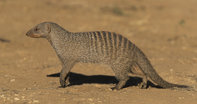
Name
Banded mongoose [Mungos mungo]Appearance
The banded mongoose has a greyish-brown fur coat with a series of dark vertical stripes running down its back and flanks. Their coats are ideal for camouflaging in the wooded areas of South Africa.
They have long bushy tails, a light underbelly while their legs are covered in a darker shade. These animals weigh about 1.5 kgs and have a triangular shaped face with round, broad ears. Males tend to weigh more than females before they reach maturity.
Banded Mongoose Diet
The banded mongoose prefers a diet of insects and mainly feeds on termites and beetles indigenous to South Africa. They are also known to prey on small rodents and snakes found in woodland areas.
The banded mongoose enjoys eating the eggs of birds and reptiles and throws the egg to help break the shell. Occasionally, the banded mongoose will rummage through garbage dumps for edible scraps.
Banded Mongoose Breeding
The prime breeding season for the banded mongoose is during the rainy season in South Africa. Litters are produced in synchrony in the pack, and each female produces an average of 2 - 8 pups per litter.
The gestation period for the banded mongoose is between 8 to 9 weeks long. Born blind and partially haired, the young open their eyes after around 10 days. As a result, of the synchronised breeding, litters are weaned collectively among females.
 Learning about the mammals of South Africa is now so much easier for all South Africans - SouthAfrica.co.za is an excellent source of inform...
Learning about the mammals of South Africa is now so much easier for all South Africans - SouthAfrica.co.za is an excellent source of inform...